Gurdjieff's concept of ReligionG.I. Gurdjieff revered Moses, Buddha, Krishna, Mohammed (namely the Sufi sect), Lama, but had a special place for Jesus Christ. Albeit, he devoted a whole chapter of his book Chapter 38 Religion to ridicule the leaders of the major religions who have distorted it for their own gain. Significantly, he conferred the original founders of these religions with the title of 'Saint' which is a Christian title. For Jesus he preferred the title of 'Sacred Individual' and 'Divine Teacher' .
The Holy Planet Purgatory
The concept of Purgatory is also a Christian concept. Gurdjieff elaborates on it in Chapter 39 as an actual planet that is described like the Hebrew New Testament: 'Garden of Eden" in Genesis 2:8. In fact like Genesis 3:8 it is visited by the 'Lord God':Chapter 39 page 747 "our ENDLESSNESS so often rejoices this holy planet with HIS appearance".
On page 746,747 Gurdjieff describes it as follows: "This holy planet is not only the center of the concentrations of the results of the functioning of all that exists, but it is also now the best, richest, and most beautiful of all the planets of our Universe. When we were there, you probably noticed that we always saw and sensed that from there all the space of our Great Universe or, as your favorites would say, all the 'skies' reflected, as it were, the radiance which recalls the radiance of the famous and incomparable 'Almacornian turquoise.' Its atmosphere is always pure like the 'phenomenal-Sakrooalnian-crystal.' Everywhere there, every individual with all his presence senses 'everything external,' 'Iskoloonizinernly,' or as your favorites would say 'blissfully-delightfully.'" On that Holy Planet, as the informed say, of springs alone, both mineral and fresh, which for purity and naturalness are unequalled on any other planet of our Universe, there are about ten thousand. There, from the whole of our Universe are gathered the most beautiful and best songbirds, of which as the informed also say, there are about twelve thousand species. And as for the surplanetary formations, such as 'flowers,' 'fruits,' 'berries,' and all others of the same kind, words are inadequate. It can be said that there are collected and acclimatized there almost the whole 'flora,' 'fauna,' and 'foscalia' from all the planets of our Great Universe. Everywhere on that holy planet, in corresponding gorges, are convenient caves of all kinds of 'interior form'- made partly by Nature Herself and partly artificially- with striking views from their entrances, and in these caves there is everything that can be required for a blissful and tranquil existence, with the complete absence of any essence-anxiety whatever in any part of the presence of any cosmic independent Individual, such as 'higher-being-bodies' can also become. It is just in these caves that those 'higher-being-bodies' exist by their own choice, who, owing to their merits, come to this holy planet from the whole of our Great Universe for their further existence."
Prior to the concept of Purgatory, people believed in the Underworld which was a barren wasteland with no escape. Since Gurdjieff believed that every three-brained being possessing a body, emotion, and thought had the possibility of obtaining a Spirit and a Soul from "conscious labors and intentional suffering", these higher-being bodies needed a place for their dwelling. Since Spirit was confined to the atmosphere of the planet of its arising and would eventually disintegrate, it was only necessary for the Soul which was eternal to have a place for its existence.
The Essenes and the concept of 'pesher'
In the above chapter Religion on at page 704, he writes:
"By the way, I may tell you here that among a rather
small group of terrestrial beings the teaching of Jesus
Christ was preserved unchanged, and, passing from generation
to generation, has even reached the present time
in its original form. This smallish group of terrestrial beings is designated
'the Brotherhood of the Essenes.' The beings of this
brotherhood succeeded at first in introducing the teaching
of this Divine Teacher into their own being-existence, and
subsequently in transmitting it from generation to generation
to later generations, as a very good means for freeing
themselves from the consequences of the properties of
the organ Kundabuffer."
The Essenes are believed to have occupied the area called Qumran on the Dead Sea where the Dead Sea Scrolls were found. Some of these scrolls used the concept of the 'pesher' where certain texts from the Old Testament were used to predict their present history. This concept was later used in the New Testament to disguise people and events from the persecution of the Romans. Thus, miracles became metaphors such as 'water into wine' and even the crucifixion, which was a miracle since Jesus survived, thus being called a Resurrection. More information can be obtained in the books, videos, and from the web site: Pesher of Christ.
The Enneagram of Jesus' six disciples
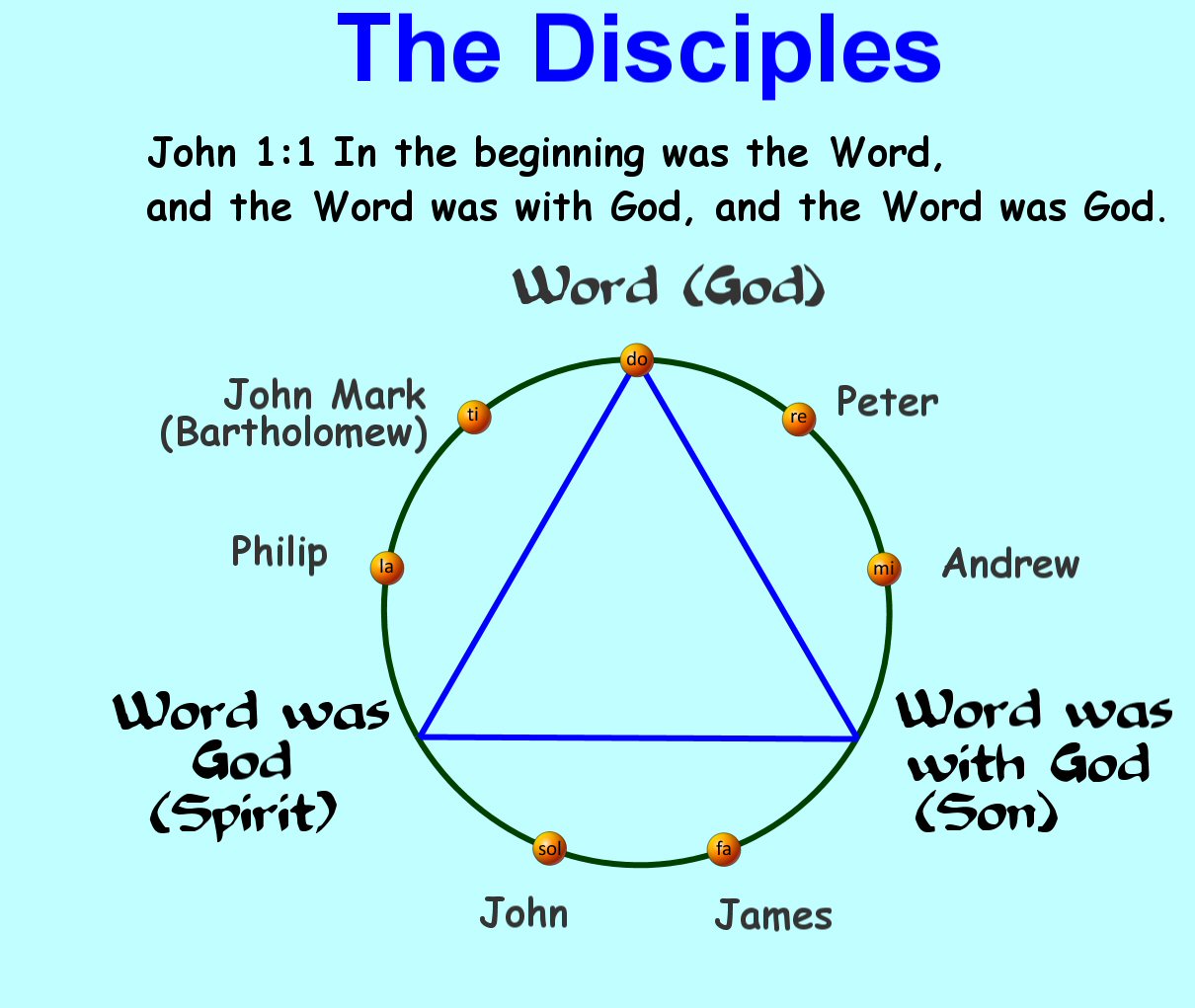
|
'The word indicates Jesus and in the New Testament: 'the word of God in Acts ' indicates a birth of a son of Jesus:
- his son Jesus Justus born 37AD with Magdalene "And the word of God increased" (Acts 06:07)
-
his 2nd son (Joseph) born in 44AD with Magdalene: "But the word of God grew and multiplied" (Acts 12:24)
- and his 3rd son with his new wife Lydia: born 51AD: "the word of God declared by Paul" (Acts 17:13)
Jesus also had a daughter Tamar/Phoebe in Mary Magdalene's womb when he was on the cross in 33AD: "Jesus, then perceiving the mother (Mary Magdalene) and the disciple standing by, whom Jesus loved (John Mark-Bartholomew), is saying to the mother of him (the mother pregnant with his child), Woman, Behold the son of you! (his expected son inside Mary Magdalene's belly" (John 19:26) |
- 1. Peter and 2. Andrew are both freedmen; Peter was married (Luke 04:38 where Jesus healed 'Peter's wife's mother'. This would be his mother-in-law: Glaphyra, daughter of the Cappadocian king Archelaus, Mother Superior of the Asher convent of Mary Magdalene)
-
3. James and 4. John are James Niceta and John Aquila. They were illegitimate twin sons of the imperial Roman descent adopted by the Syrophoenician woman: Martha (Luke 10:38-39) (Helena of the Clementines) being the consort of Simon Magus thus they are adopted "sons of Zebedee" (Mark 10:35); John Aquila was married to Priscilla (Acts 18:2)
-
5. Philip "had four unmarried daughters, who prophesied" in Caesarea. (Acts 21:8-9) Daughter #4 is Mary Magdalene
-
6. John Mark (Bartholomew)is "the disciple Jesus loved" (John 13:23). He is Mary Magdalene's guardian (See John 19:26).
|
The Enneagram of Jesus' Hierarchy
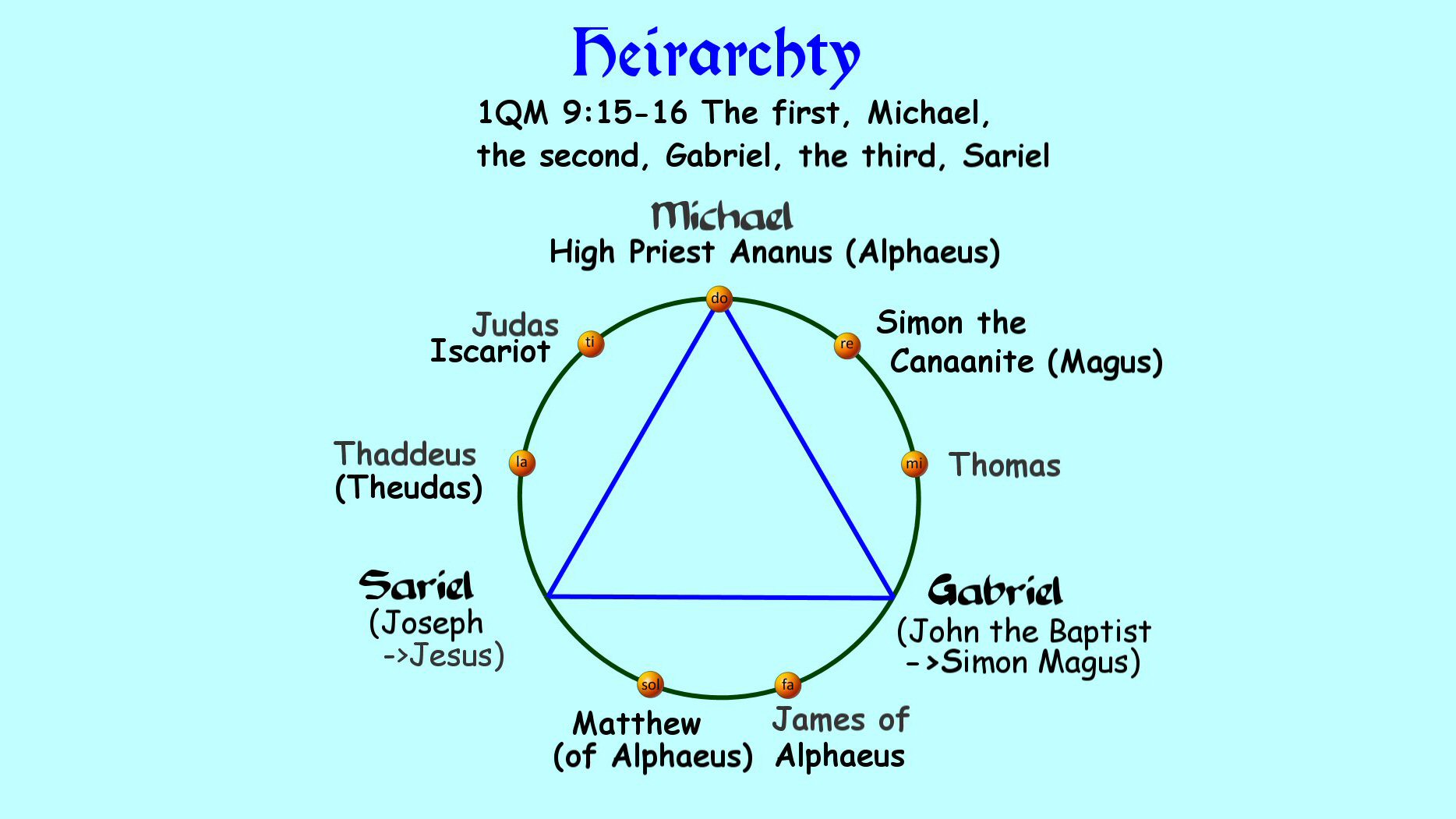
|
The Essenes defined their leaders by the angels thus 'Gabriel' in position 2 (Luke 1:26) Simon the Essene (Luke 2:25) spoke to Mary to tell her that her conception of Jesus would be approved although she was merely betrothed and not yet married. He shows that this conception was not immaculate: (Luke 1:35 "The angel answered and said unto her, The Holy Spirit (3rd Position Joseph) shall come upon thee ..."
Herod the Great was the nominal 'Michael', but at his death in 4 BC, then to Herod Archelaus, then to Herod Antipas, Tetrarch of Galilee. Ananus would replace the High Priest Joazar Boethus (the dragon - Rev 12:7) in 6AD as the Michael. Joseph is killed in 23AD (Parable of the widow's mite (Mother Mary)).
In 31 AD John the Baptist (Gabriel) is deposed by Herod Antipas and later beheaded and Simon Magus takes his position (Clementine Recognitions 2:11) with Jesus becoming "Sariel". The supporters of John the Baptist say in Mark 3:22 and "He (Jesus) has Beelzebub," and -- "By the ruler of the demons (Simon Magus) he does cast out the demons."
1. Simon the Canaanite/Zealot/Magus-magician Not mentioned in the Gospels, but is in Acts 8:9 "But there was a man named Simon who had previously practiced magic in the city and amazed the nation of Samaria, saying that he himself was somebody great."
2. Thomas called 'Didymus' meaning twin which is a Biblical reference to Esau and Jacob where Jacob stole Esau's inheritance. (Also 'Rufus son (subordinate) of Simon (Magus)' since Esau had red hair. Mark 15:21 "And they compelled a passer-by, Simon of Cyrene, who was coming in from the country, the father of Alexander and Rufus, to carry his cross."
Herod the Great had promised the kingship to Thomas, but when his mother was implicated in a plot to kill Herod, he was dispossessed. (Josephus, Antiquities 17, 77-78, Josephus, Wars 1, 600). Salome who danced for Herod was actually Thomas's daughter and half daughter of Herod Antipas because Antipas had married Herodias which caused the beheading of John the Baptist.
3. James of Alphaeus (Ananus) and 4. Matthew were two of the so-called tax collectors because the collected the Church tithes were two of the five sons of the High Priest Ananus who also became High Priests. Matthew was instrumental in publishing the four Gospels (Four Horsemen of the Apocalypse: Matthew (white), Mark (red), Luke (black), John (green) in 47/48 AD. James is Jonathan (Nathaniel) and was the one whom Jesus called 'Father' (as Gabriel, his superior - Simon Magus excommunicated) in the Garden of Gethsemane Luke 22:42 "Father, if thou art willing, remove this cup from me; nevertheless not my will, but thine, be done." 5. Thaddeus (Theudas) has many names as one of the remaining leaders of the Zealot resistance under Judas the Galilean. He is actually the brother of Joseph, thus Jesus' uncle. As Barabbas ("subordinate of the Abbot") he was supposed to be crucified with Simon Magus who had been excommunicated, but 'raised from the dead' by Jesus. Jesus was substituted because he being old would not have survived the plan to use a three hour time change and the reason that Jewish law stated that no man could be left on the cross at sundown before the Passover. He is also Nicodemus who supplied "an hundred pound weight of myrrh and aloes"!: the antedote.
Finally there is 6. Judas Iscariot (a Zealot Sicarii carrying sicae, or small daggers, concealed in his cloak) whom Gurdjieff refers as "the devoted and favorite Apostle initiated by Jesus Christ Himself" Chapter 38 Religion Page 739. He claims that Judas purposely delayed the guards so that Jesus could complete the sacred process Almznoshinoo with the disciples so that after his death they would be able to communicate with them.
"That process is called the sacred Almznoshinoo by means of which three-centered beings who have themselves already had time to coat and to bring their own body Kesdjan up to completed functioning and to a definite degree of Reason, intentionally produce the coating or, as it is otherwise said, the ‘materialization’ of the body Kesdjan of any being already entirely destroyed, to such a density that this body acquires again for a certain time the possibility of manifesting in certain of its functions proper to its former planetary body." Chapter 38 Religion Page 726
Whether this is true or not, Gurdjieff was clearly influenced by Coptic "Gospel of Judas" which was condemned by Irenaeus . (130 – c. 202 AD). Irenaeus was Bishop of Lugdunum in Gaul (Lyon, France). He was an early Church Father and apologist, and his writings were formative in the early development of Christian theology. Irenaeus is recognized as a saint in both Roman Catholicism and Eastern Orthodoxy. His most famous of his writings is 'Against Heresies', which was aimed against the Gnostics. He considered himself to be superior to them because as a student of Polycarp, who was in touch with John the Evangelist (son of John, the brother of James, therefore John II), he had a direct connection with Jesus. He is one of the preeminent early Christian Fathers, venerated in the following Churches: Roman Catholic, Lutheran, Eastern and Oriental Orthodox, Anglican Communion, and Eastern Assyrian.
In "Against Heresies" (c. 180AD), (The Ante-Nicene Fathers. translations of the writings of the fathers down to A.D. 325 Vol 1 edited by Roberts and Donaldson - paraphrased) Irenaeus writes, "Jesus, in his thirties, being in fact still a young man, suffered on the cross, but this was merely the first stage of his early life that would extend onwards past his fortieth year. Even though a man begins to decline towards old age towards his fiftieth year, Jesus continued to fulfill his role as a Teacher as the Gospel and all the elders testify. These elders in Asia were conversant with the son of John, the disciple of Jesus, who remained among them up to the times of Trajan (98AD)." This indicates that there would be no need for the 'sacred Almznoshinoo'.
Irenaeus was not the only one to say the Jesus survived the cross as Eusebius who succeeded Agapius as Bishop of Caesarea soon after 313AD. Being a learned man and famous author, and thus enjoying the favor of Emperor Constantine, he played a prominent role at the Council of Nicaea in 325AD. When he wrote his Church History, he must have had the works of Papias before him, but they have since been lost. Papias of Hierapolis (died c. 100AD) is described by Irenaeus (previously quoted above) as "an ancient man who was a hearer of John and a companion of Polycarp". Polycarp (69-155AD) was a Christian bishop of Smyrna, one of the Seven Churches of Revelation in 48AD. With Clement of Rome (the first Pope) and Ignatius of Antioch, Polycarp is regarded as one of three chief Apostolic Fathers. His sole surviving work attributed to his authorship is his Letter to the Philippians (first recorded by Irenaeus). Polycarp must have had strong connections with Papias at Hierapolis which is where the Apostle Philip lived and whose bones are said to be buried.
Eusebius records the fragmented words of Papias that tell of wonderful events that have come down to him by tradition. Papias was a contemporary of Philip the Apostle who resided in Hierapolis with his daughters (Acts 21:08). He relates a marvelous tale from the daughters of Philip:
"that in his time a man rose from the dead1, and again
how Justus2 who was surnamed Barsabbas3 drank a deadly poison, and yet, by the grace of the Lord, suffered no serious harm."
(1) This is obviously Lazarus (shown to be Simon Magus)
(2) This is Jesus, although Eusebius has mistaken him for James the Just in the next phrase from Papias: "And they put forward two, Joseph, called Barsabbas, who was surnamed Justus, and Mathias." The Clementines says that Mathias is Joses. Justus means crown prince used by James, younger brother of Jesus and later by Jesus' son: Jesus Justus, the true crown prince (Colossians 4:11).
Thus the choice is between Jesus' brothers: James and Joses.
(3) The prefix 'Bar' in Barsabbas means "son of", thus "son of Sabbas." It is used in Acts 1:23 for James (Joseph Barsabas), in Acts 4:36 Joses (called by the corrupted Bar-nabas) and in Acts 15:22 for Jude (Judas called Barsabas) with Silas (Simon). (Brothers of Jesus: Mark 06:03 "Is not this the carpenter, the son of Mary, and brother of James, and Joses, and Jude, and Simon?" |
It is interesting to note that from the Syro-Aramaic roots of the Koran, Jesus escapes the cross. This also told in the Nag Hammadi Coptic Codex VII: "The Second Treatise of the Great Seth". Both claiming that it was someone else.
Gurdjieff was right that Judas was not as evil as people assume. His position was as a "tester", thus called "Satan", overseeing Jesus when he spent 40 days in the wilderness to prepare for marriage. In that story Jesus refused Judas' offer to welcome Jesus as "Sariel" when he took over the position of "Gabriel". In Luke 8:2 "Mary, called Magdalene, from whom seven demons had gone out" shows Judas' position as "Demon #7" as Magdalene's superior, released when she was betrothed to Jesus.
There can be no disputing that Judas betrayed Jesus for in Luke 22:48 Jesus said "Judas, would you betray the Son of Man with a kiss?". Judas asked for 30 pieces of silver, but that was merely a metaphor for what he requested. He was wanting to take over the position of Gabriel which was John the Baptist's position. John the Baptist' was also the leader of 30 members based on the moon's silver cycle of 30 days. In the Clementine Homilies 2.23 "There was one John, a day-baptist, who was also, according to the method of combination, the forerunner of our Lord Jesus; and as the Lord had twelve apostles, bearing the number of the twelve months of the sun, so also he, John, had thirty chief men, fulfilling the monthly reckoning of the moon's cycle (triacontad), in which number was a woman, being half a man, made up the imperfect of 29 and one-half days ... was a certain woman called Helena.(Syrophoenician woman/Martha)"
Judas' ambitions resulted in being placed on the third cross with Jesus and Simon Magus (Luke 23:39-43):
- "One of the criminals (Judas) who were hanged railed at him, saying, 'Are you not the Christ? Save yourself and us!'.
- But the other (Simon Magus) rebuked him, saying, 'Do you not fear God, since you are under the same sentence of condemnation? And we indeed justly; for we are receiving the due reward of our deeds; but this man has done nothing wrong.'
And he said, 'Jesus, remember me when you come into your kingdom.'
-
And he (Jesus) said to him, "Truly, I say to you, today you will be with me in Paradise."
All three were rescued and revived in the two tombs (Paradise), but later he was hurled down the slope as described in a "field of blood" Act 1:19 (Gehenna: Hell).
Further Analysis:Although in his Chapter Religion Gurdjieff disappoints with his justification of Judas' actions and thus attributing the Resurrection to the sharing of "blood and wine" at the Last Supper, it is does not negate the significance of this sacrament as a metaphor for the connection to the Kesdjan (astral) body. In my essay The Three Body Enneagram, I have defined two important positions "Agápe Love" and "Purgatory":
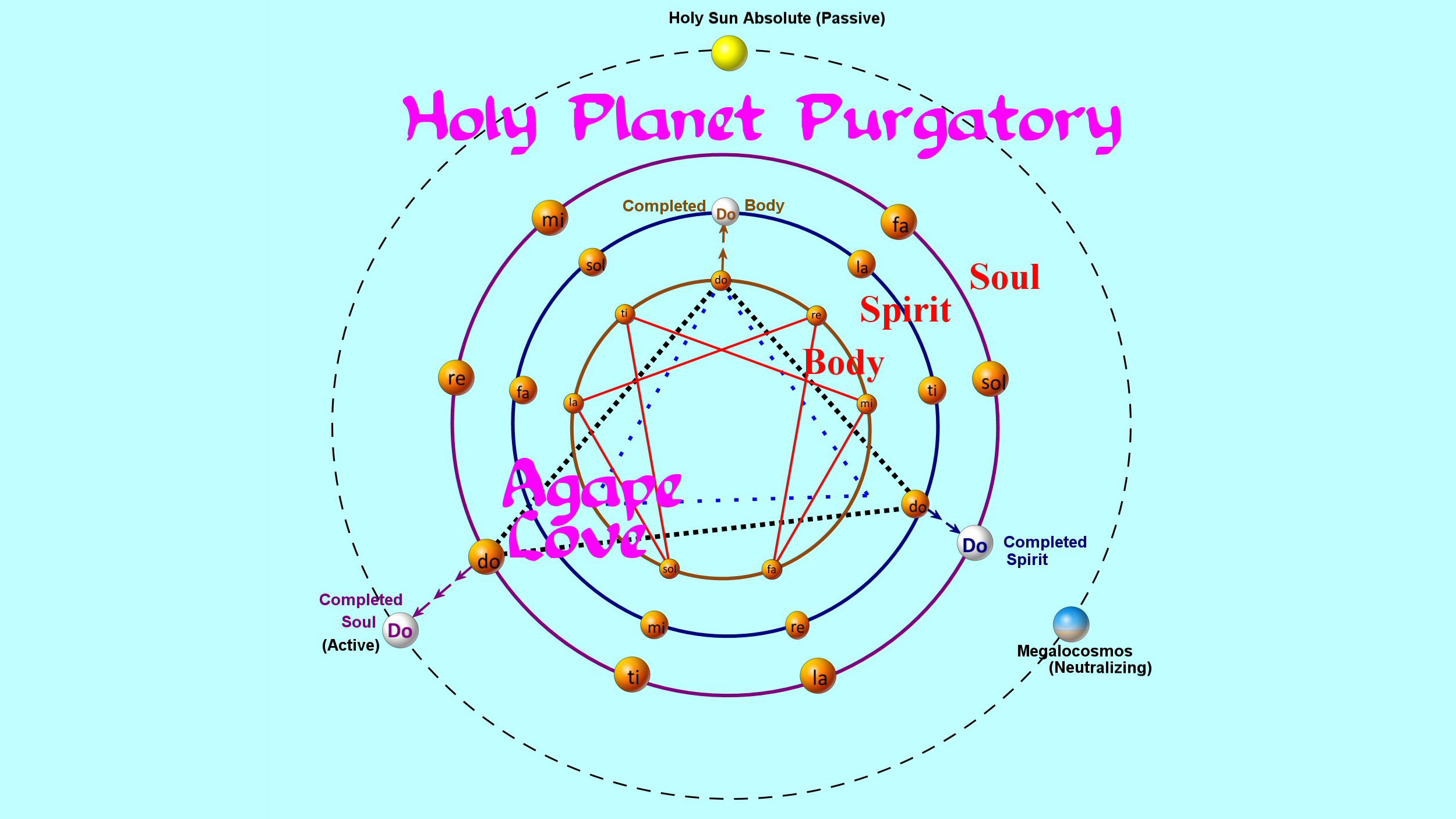
As to Agápe Love, I have identified in my essay: The Key to Soul Is Within The Missing Stopinder in the Food Octave the missing position between 'sol' and 'ti' of Gurdjieff's Food Octave that I named " "Hormoneary". You will note that its position is significant as the place where the second body Spirit (Kesdjan/ astral/emotional) Body that began in the lungs at the "first point of Action" (often called "discontinuity") between 'mi' and 'fa' of the Body Octave reaches its "first point of action" that requires an extra boost at its 'mi'-'fa'.
In my presentation at All & Everything Conference The Proceedings of the 23rd International Humanities Conference: ALL and Everything 2018 I suggested that this is the place where "agápe love" is needed. (In Ouspensky terminology this is called "impartiality", but this often leads to callousness" when applied to the mind and not the emotions). Instead I refer you to John 21 where Jesus tries three times to teach Peter that "filia love" is not "agápe love" (which is love that does not expect a return). This is the foundation of the Spirit Body (Kesdjan/astral/emotional) and the true "blood" connection of the Last Supper which is at the heart of Christianity.
As to Purgatory, it can be seen that the Soul Body reaches a similar point in its point of action 'mi' and 'fa' which is the higher 'do' of the Body Octave. This Completed Body is now in the realm after death and needs a place for its existence: thus the "Holy Planet Purgatory". You can see the without support of his Endlessness this Completed Body that feeds the Soul in its completion could easily slip down into the realm of sex at 'ti' Exioehary) and thus my other essay: The Soul is Sex but Sex is not Soul. |
The Three Engines of Body, Spirit, and Soul: (See Photonic Soul)
For the Body it is: - ('do') (AO)(0)
- ('mi-fa') (AA)(3)
- ('sol-la') (IA)(6)
- ('ti-Do') (AO)(9)
| Body |
|---|
| 0 | (do) (AO) food in stomach (-) | duodenum | liver |
| 3 | (AA) air in lungs (+) | cerebellum
first chakra | cerebrum |
| 6 | (IA) sensory system (=) | endocrine system
third chakra | sexual system
second chakra |
| 9 | 'Do' (incepting/converging AO) (-)
completed Body (Ternoonald)
mind, emotions, body in balance
(Purgatory) | |
For the Spirit it is: - ('mi-fa') (AO)(3)
- ('sol-la') (AA)(6)
- ('ti-Do')(IA)(9)
- ('Mi-Fa')(AO)(Second octave: 9+3=12=3)
| Spirit |
|---|
| 3 | (do) (AO) oxygenated blood (-) | heart
fourth chakra | thymus
fifth chakra |
| 6 | (AA) agápe love (+) | spleen | kidneys/adrenal |
| 9 | (IA) insight/epiphany (Ternoonald) (=) | hypothalamus
sixth chakra | pineal
seventh chakra |
| 12(3) | 'Do' (incepting/converging AO) (-)
completed Spirit (Podkoolad) | |
For the Soul it is: - ('sol-la') (AO)(6)
- ('ti-Do') (AA)(9)
- ('Mi-Fa')(IA)(Second octave: 9+3=12=3)
- ('Sol-La)(AO)(Second octave: 9+6=15=6)
| Soul |
|---|
| 6 | (do) (AO) photons inputted
by the five senses (-) | Vestibular System | Proprioception |
| 9 | (AA) contemplation/meditation (+) | parietal lobe | occipital lobe |
| 12(3) | (IA) Active Mentation (Podkoolad) (=) | temporal lobe | frontal lobe |
| 15(6) | 'Do' (incepting/converging AO) (-)
completed Soul (Anklad Body) | |
|
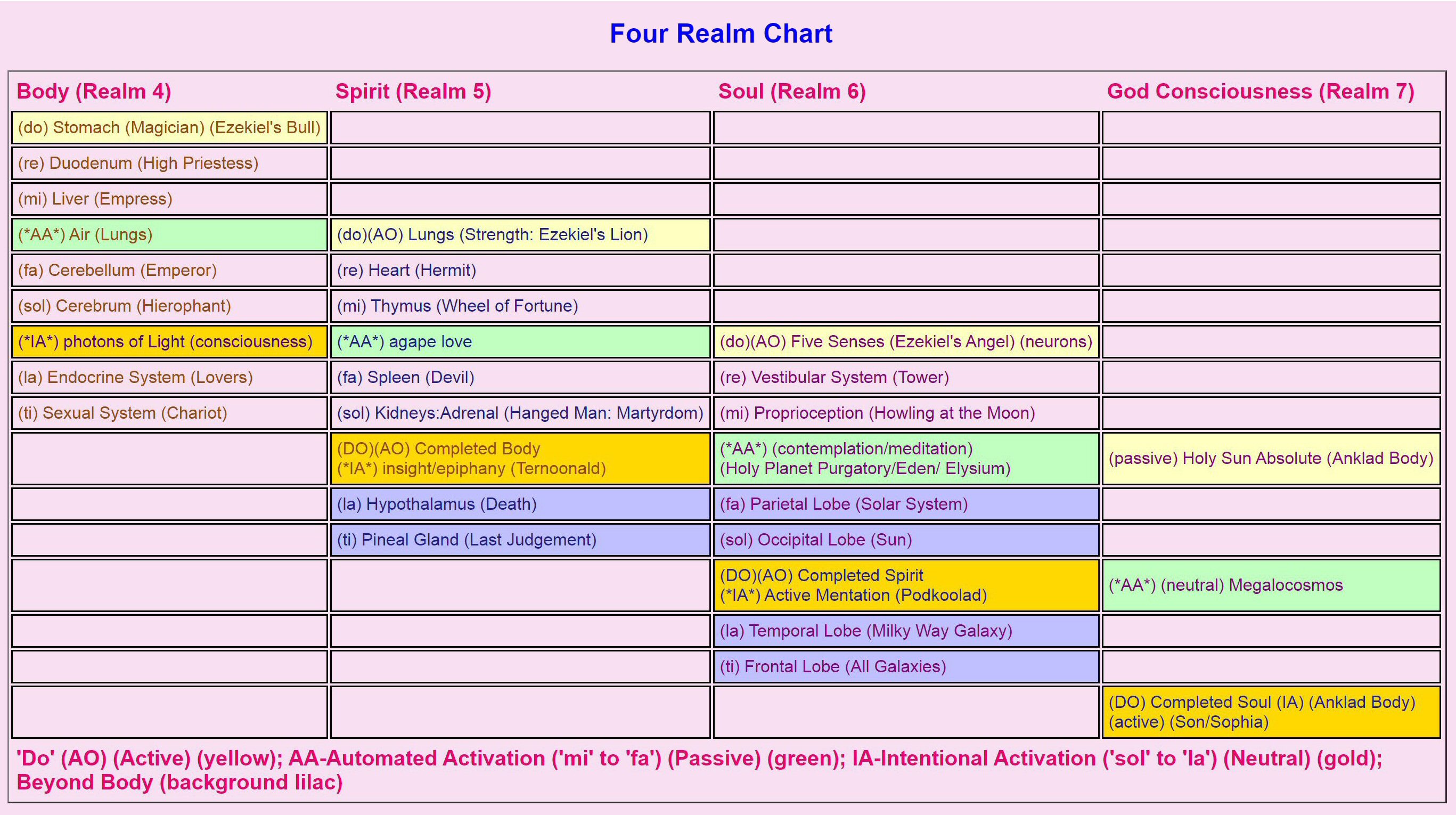
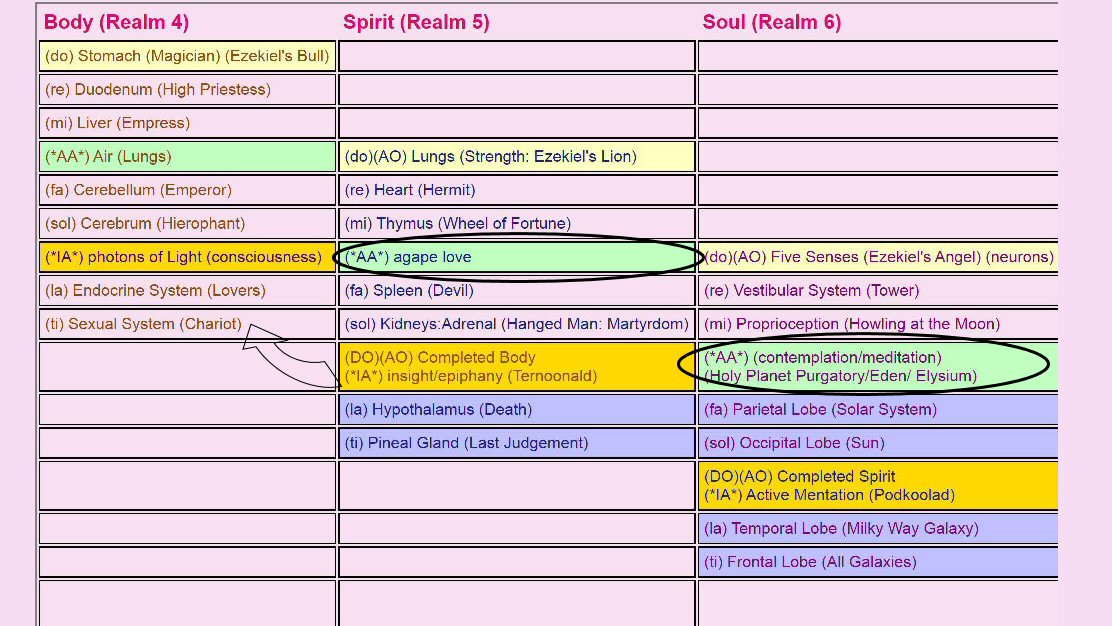
|




